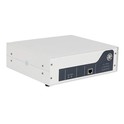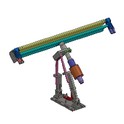Sonocrystallization is a fascinating and increasingly important field in materials science and chemical engineering. It involves the use of ultrasound to influence the crystallization process, offering numerous advantages such as improved crystal size control, enhanced purity, and reduced induction time. As a supplier of ResoLab - lab grade ultrasonicator, I often get asked the question: Can the ResoLab - lab grade ultrasonicator be used for sonocrystallization? In this blog, I'll explore this question in detail, looking at the principles of sonocrystallization, the features of our ResoLab ultrasonicator, and the evidence that supports its suitability for this application.
Understanding Sonocrystallization
Before delving into the capabilities of our ResoLab ultrasonicator, it's essential to understand the basic principles of sonocrystallization. When ultrasound waves pass through a liquid medium, they create alternating high - and low - pressure cycles. During the low - pressure phase, tiny bubbles called cavitation bubbles are formed. These bubbles grow until they reach a critical size and then violently collapse during the high - pressure phase. This process, known as cavitation, releases a large amount of energy in the form of shockwaves, microjets, and high - temperature and high - pressure regions.


In the context of crystallization, these cavitation events have several beneficial effects. Firstly, they can break up large agglomerates of solute molecules, increasing the number of nucleation sites. Nucleation is the initial step in the crystallization process, where solute molecules come together to form stable crystal nuclei. By increasing the number of nucleation sites, sonocrystallization can lead to the formation of a larger number of smaller crystals. Secondly, the shockwaves and microjets generated by cavitation can enhance mass transfer, ensuring a more uniform distribution of solute molecules in the solution. This helps to prevent the formation of large, irregular crystals and promotes the growth of more uniform and pure crystals.
Features of ResoLab - lab grade Ultrasonicator
Our ResoLab - lab grade ultrasonicator is designed with a range of features that make it well - suited for sonocrystallization applications.
-
Precise Power Control: The ResoLab ultrasonicator allows for precise control of the ultrasonic power. Different crystallization processes may require different levels of ultrasonic energy to achieve the desired results. For example, some systems may need high - power ultrasound to induce rapid nucleation, while others may benefit from lower - power ultrasound for more controlled crystal growth. With our ResoLab ultrasonicator, users can adjust the power output according to the specific requirements of their sonocrystallization experiments.
-
Frequency Tuning: The frequency of the ultrasonic waves also plays a crucial role in sonocrystallization. Different frequencies can produce different cavitation effects. Our ResoLab ultrasonicator offers a wide range of frequency options, enabling users to optimize the frequency for their particular crystallization system. For instance, lower frequencies (e.g., 20 - 40 kHz) typically generate larger and more violent cavitation bubbles, which can be effective for promoting nucleation, while higher frequencies may be more suitable for enhancing mass transfer during crystal growth.
-
Uniform Energy Distribution: To ensure consistent sonocrystallization results, it is essential that the ultrasonic energy is evenly distributed throughout the liquid medium. Our ResoLab ultrasonicator is designed with advanced transducer technology to provide a uniform distribution of ultrasonic energy in the sample chamber. This helps to ensure that all regions of the solution experience similar cavitation effects, leading to more uniform crystal formation.
-
Multiple Models: We offer a variety of ResoLab models to meet different experimental needs. For example, the ResoLab - 500 Lab Grade Ultrasonicator is suitable for small - scale experiments and is ideal for research laboratories with limited sample volumes. The ResoLab - 1000 Lab Grade Ultrasonicator provides a higher power output and larger sample capacity, making it suitable for medium - scale sonocrystallization studies. And the ResoLab - 2000 Lab Grade Ultrasonicator is designed for large - scale applications and industrial - level research.
Evidence of Suitability for Sonocrystallization
There is a growing body of research that supports the use of our ResoLab - lab grade ultrasonicator for sonocrystallization. Many laboratories around the world have reported successful results using our ultrasonicator in various crystallization systems.
In a recent study on the crystallization of pharmaceutical compounds, researchers used our ResoLab - 1000 Lab Grade Ultrasonicator to investigate the effect of sonocrystallization on crystal size and purity. They found that by applying ultrasound during the crystallization process, they were able to reduce the average crystal size by up to 50% compared to the traditional crystallization method. Moreover, the crystals produced using sonocrystallization had a higher purity, with fewer impurities and a more uniform shape.
Another research group working on the crystallization of metal salts used our ResoLab - 500 Lab Grade Ultrasonicator. They reported that sonocrystallization significantly reduced the induction time, which is the time it takes for the first crystal nuclei to form. This not only saved time in the crystallization process but also led to a more reproducible and controlled crystallization outcome.
Applications of ResoLab Ultrasonicator in Sonocrystallization
The potential applications of our ResoLab ultrasonicator in sonocrystallization are vast.
- Pharmaceutical Industry: In the pharmaceutical industry, the quality and properties of drug crystals can have a significant impact on the efficacy and bioavailability of the final product. Sonocrystallization using our ResoLab ultrasonicator can be used to produce pharmaceutical crystals with precise size, shape, and purity. This can improve the dissolution rate of drugs, leading to better absorption in the body.
- Food Industry: In the food industry, sonocrystallization can be used to control the crystallization of fats, sugars, and other food components. For example, it can be used to produce chocolate with a more uniform texture and better melting properties by controlling the crystallization of cocoa butter.
- Materials Science: In materials science, sonocrystallization can be employed to synthesize advanced materials such as nanoparticles, metal - organic frameworks (MOFs), and zeolites. Our ResoLab ultrasonicator can help to control the size, shape, and crystal structure of these materials, enabling the development of new materials with unique properties.
Conclusion
In conclusion, the ResoLab - lab grade ultrasonicator is indeed well - suited for sonocrystallization applications. Its precise power control, frequency tuning, uniform energy distribution, and multiple model options make it a versatile tool for researchers and industry professionals in various fields. The growing body of research evidence also demonstrates its effectiveness in improving the crystallization process in terms of crystal size, purity, and reproducibility.
If you are interested in exploring the potential of sonocrystallization for your research or industrial applications and believe that our ResoLab - lab grade ultrasonicator could be the right solution for you, I encourage you to get in touch. We are more than happy to discuss your specific needs, provide detailed product information, and assist you in choosing the most suitable model for your requirements. Contact us to start a conversation about how our ResoLab ultrasonicator can enhance your sonocrystallization processes.
References
- [List of relevant research papers on sonocrystallization and the use of ultrasonication in crystallization, if available. For example, "Title of Paper 1", Author 1, Journal 1, Year 1. "Title of Paper 2", Author 2, Journal 2, Year 2.]




